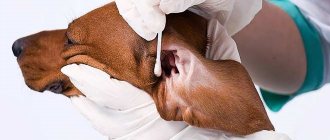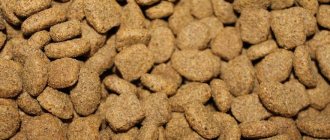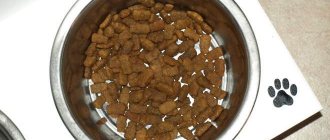Discharge in a pregnant dog is normal. Discharge refers to the appearance of fluid or mucus other than urine from a loop. Normally, in a healthy dog, the loop is always slightly moistened, the discharge is clean, transparent and odorless, does not collect in drops, and does not contain thick mucus. But sometimes the discharge changes and this often worries the owners. Dog breeders pay especially close attention to discharge from dogs during pregnancy. They can be different throughout the pregnancy and depending on whether it proceeds safely. Therefore, it is very important for the owner to monitor his dog.
What kind of discharge does a pregnant dog have?
Discharge during pregnancy in dogs is a normal physiological phenomenon. They are always present in small quantities and provide balance to the mucous membrane of the dog’s genital tract (if the discharge is in a male, then this is for you).
Immediately after mating with a male dog, the bitch’s discharge, as expected, stops, by which the owner learns that the dog is in heat and is ready for fertilization. Instead, whitish-transparent thick drops may be released. This is a kind of reaction of the mucous membrane of the female genital tract to the seminal fluid of a male dog. It is possible that the discharge is light pink, spotting, and mucous. In the first days after mating the bitch - preliminary or control - this discharge should stop.
Three weeks after mating, if the bitch is fertilized, her cervix closes. This is accompanied by discharge that resembles water in consistency and transparency and has a slight admixture of mucus. Mucus is the excess mucus plug that covers the cervix. A slight presence of bloody inclusions is allowed in the plug - this is the release of unfertilized or fertilized, but dead, eggs.
About a month after fertilization, thick translucent mucus is released from the loop of the pregnant bitch. In nature, it forms a protective barrier, drying in the lumen of the loop and gluing it together after each urination. Dried mucus resembles a wound covered with ichorous crust. It is advisable to wash your pet dog with clean water without soap or wipe its loop with baby sanitary napkins or special ones for veterinary use. If you do not remove the crust, hair will begin to stick to it, and the dog will look very unkempt.
Prevention
It is impossible to completely exclude the possibility of developing a pathological process, but some preventive measures will allow the owner to prevent the advanced stage of the disease. To reduce the risk of pathology, the following procedures must be carried out:
- vaccination;
- proper hygiene;
- regular checkups with a veterinarian.
Those animals that are not being prepared for mating must undergo a sterilization procedure.
Diagnostics
Any discharge from a dog's loop requires attention from its owner. But his particular concern, in addition to the above, should be:
- the occurrence of severe thirst;
- deterioration in coordination of movements;
- bloody trail after urination;
- swollen condition of the animal's loop.
If you notice at least one of these manifestations, your pet should be taken to the veterinarian. After all, such symptoms are a direct indication of the inflammatory process in the uterus. There the animal will be examined and the necessary tests will be performed, including:
- laboratory tests of blood and urine;
- bacteriological examination of the microflora of the urinary tract and vagina;
- vaginal smear for cytology;
- abdominal x-ray;
- Ultrasound;
- biopsy of vaginal abnormal tissue;
- examination of the vagina and cervix;
- test determination of possible damage by brucellosis and herpes;
- coagulation (for poor blood clotting), etc.
There are a lot of diagnostic methods, and they allow you to determine the exact picture of the illness, as well as prescribe appropriate therapy.
Symptoms
Particular attention should be paid to additional symptoms that appear. They will tell you what exactly happened and help you prescribe more precise treatment, so immediately tell your doctor about all the symptoms you notice. When diagnosing, every little detail can be important.
Most dogs are very clean. They constantly lick the genitals, thereby removing much-needed traces and complicating the diagnosis. In such cases, you can understand that something is wrong by indirect signs:
- Showing anxiety.
- Worsening appetite.
- Pathological need to drink a lot.
- Apathy and drowsiness.
- Aggression.
- Constant licking of the loop.
- Fever.
- Attempts to rub the genitals on the floor.
- Nausea.
- Diarrhea.
It is impossible to determine the exact cause of the manifestation of one or another combination of symptoms without special research.
Treatment options
If a pathology is detected, it can be both surgical and medicinal:
- complete removal of the uterus or surgical removal of a foreign body found in it, as well as tumors;
- surgery to correct congenital changes in the rectum, vagina or ureters;
- antibacterial effect of drugs on infectious, bacterial lesions, inflammation resulting from injury
- drug therapy for poor blood clotting; chemotherapy when tumors are detected.
Simple pathologies allow treatment at home. True, the owner will need to make a lot of effort and be patient for this. It is important not only to strictly follow the veterinarian’s recommendations, but also to show your dog love, affection and care. In case of pathological discharge from your pet’s uterus, even of a minor nature, self-medication is not recommended. The end of such an attempt can be very sad.
Based on this, I would like to emphasize once again: as soon as you notice discharge from the loop in an animal that is not associated with estrus or the postpartum period, be sure to show it to a specialist who will determine the cause and prescribe treatment. After all, this is the only way to get rid of the problem in a timely manner and save his life.
Vaginal tumors
Another reason for the appearance of brown discharge in a bitch is tumors that grow in the vagina or on the vulva. They can be benign or malignant, although the latter is rare. They are more common in older dogs, over ten years of age.
They cause discharge or bleeding, and sometimes this appears as a bulging mass coming out of the vulva. The bitch licks vigorously and urinates more often. Large tumors deform the perineal area. The preferred treatment is usually surgery. However, tumors can grow back.
Discharge after mating
If a bitch was mated with a male, there is no guarantee that conception occurred. It is worth knowing that after an unsuccessful mating, a false pregnancy may periodically appear even without the participation of a male dog. The appearance of the female resembles her behavior during pregnancy, including physiological changes, but the veterinarian will be able to determine for sure whether conception has occurred.
Most bitches, after successful conception, may not respond to semen in any way, and estrus continues for several days. Only after a while does the discharge disappear. It is possible to accurately identify that an animal is pregnant by the presence and quality of discharge.
The owner who monitors the health of his pet should be wary of the appearance of blood in the mucous secretions. Mostly blood is a negative factor and indicates any abnormalities in the body, but there are cases when such a phenomenon is considered within normal limits. Most likely, the bitch’s body reacts to the process of conception by secreting blood.
Is there anything I need to do?
In the wild, no one helps an animal produce offspring. Sometimes that's good. The dog takes care of itself independently and leads a measured existence. A person, observing mucus from the vagina, usually panics, wanting to stop the process.
The dog owner should be prepared for discharge within 56-72 days - that’s how long gestation lasts. To prevent your shaggy friend from walking around dirty, you can wash the dog.
There is no need to stop the copious secretion with an unpleasant odor either. You should contact the veterinarian observing the animal and consult with him.
The appearance of blood in the discharge
It is worth noting that such a signal is not always a consequence of pathology. If the discharge does not last long, the dog’s activity does not change in any way, the color of the blood is quite dark, and the amount is small, then there is no serious cause for alarm.
Mostly 1-2 days before birth, a clear or white liquid is released from the loop. In some cases, light green or brown mucus may appear. The brown color is a consequence of getting into the blood secretions. The reason is burst capillaries, as a result of dilatation of the cervix. There is nothing serious in this case; such a signal indicates an imminent birth. Eclampsia may occur.
It is normal for the mucus plug to peel off 20-40 hours before birth, which is accompanied by blood and a yellowish color. In this case, the discharge may be insignificant and even unnoticeable.
If the discharge of blood is profuse and the mucus turns dark brown in color, it is likely that one puppy has died, which requires a visit to the veterinarian; birth at home cannot be performed. A large amount of dark or light blood may indicate that the uterus has ruptured; this is dangerous for the health of the animal and the fetus. The dog will need urgent hospitalization and help from a veterinarian.
It is normal for blood to appear for some time after childbirth, mostly healing occurs after 2-3 days. If blood clots continue to be released, there is a high risk of bleeding in the uterus, which can only be eliminated in the clinic with the help of hemostatic drugs, but they have many contraindications and therefore require medical supervision.
In general, excessive bleeding is always a sign of pathology. Small particles of red or brown color should alert the owner, but there is no need to take any action for treatment. It is advisable to consult a doctor.
The course of pregnancy after 1 month
At this stage, before the crust forms, long green or black clots may stretch from the loop - these are embryos that died in early pregnancy. There is nothing wrong with this; this is a normal scheme for cleaning a dog’s uterus provided by nature. If the dead embryos remain in the uterus, they will mummify and be expelled during childbirth. There is nothing dangerous in this either (a complete list of the course of pregnancy by day).
If the bitch is not fertilized, she also needs to be monitored. Such discharge, coupled with swollen milk bags and saggy nipples, may indicate a false pregnancy - an extremely undesirable hormone-dependent condition that negatively affects the reproductive health and psyche of the dog. A dog with signs of a false pregnancy should be taken to a veterinarian to evaluate the condition and possibly prescribe hormonal medications.
It will be informative about discopathy in dogs
24-36, sometimes 48 hours before whelping, the bitch’s mucous plug comes off. This is a clot of mucus of a transparent, whitish brown color. The release of the mucus plug is the first clear sign of the bitch preparing for childbirth. She becomes either very nervous or abnormally relaxed, looking for a nest, trying to dig a hole in the floor or in the yard, preparing a place for the puppies. During this period, the most peaceful, calm environment should be created for the pregnant dog. Some bitches seek the company of their owner, while others want complete privacy during childbirth. Your pet's choice should be respected, but you should constantly monitor her and be ready to help her.
When is veterinary care needed immediately?
In the following situations, professional help is recommended:
- When the discharge is bloody. This may be evidence of uterine rupture. Uterine rupture is a dangerous life-threatening condition in which only a highly qualified veterinarian can provide competent assistance. Most likely, it will not be possible to save the puppies; the uterus will also have to be removed. Veterinarians recommend removing the ovaries along with the uterus - castrating the dog in order to avoid false pregnancies due to “empty” heats and to prevent tumors of the milk bags.
- When a pregnant dog's discharge from the loop has a foul odor. This is usually a sign of inflammation when both the puppies and the bitch are infected. Timely help will save the puppies. The stench may indicate intrauterine death of the litter and the beginning of the decomposition process. In this case, immediate surgery is required to remove the dead puppies. Even if there are still living puppies in the uterus, the bitch will probably not be able to bear them, since they are infected and will die sooner or later
- When the discharge is green. Green discharge is also a clear sign of infection, and intrauterine. They may also indicate placental abruption. Both conditions are dangerous for both the pregnant dog and the premature litter.
- When pus is released from the loop. This means that the inflammatory process in the uterus develops rapidly and is aggravated by the general weakened state of the dog’s body.
Kinds
Through the loop, mucus and fluids formed in the genital tract and vagina are released; from them it is always easy to understand whether everything is in order with the health of the pet in this part of the body.
We are accustomed to the leakage of fluid during estrus and immediately after childbirth; this process is the norm. However, in addition to bloody discharge, indicating readiness for mating, and brownish postpartum discharge, there are many types of mucus that indicate the bitch’s ill health:
- Whitish and greyish, purulent discharge, often stinking.
- Green and yellow, smelling sour.
- Bloody.
- Transparent.
- Brown and dark brown.
- Bleeding.
Having seen this, the owner immediately goes to the clinic, because such symptoms cannot indicate anything good. Even during periods of sexual activity, abnormal color or profuseness suggests that the animal is sick.
Final conclusions
In a pregnant dog, mucous discharge during normal course is slightly present. They change throughout pregnancy and this is also considered normal. It is necessary to note the nature of the dog’s discharge from the loop - color, thickness, transparency, smell, presence of blood, clots, fibers and report them to the veterinarian. A complete medical history will allow the veterinarian to prescribe the necessary diagnostic measures and make an accurate diagnosis.
It would be nice to know how the pregnancies of the dog’s mother and grandmother proceeded. This information will allow you to navigate and prepare for possible options for the development of the situation. Finding a mother and grandmother is not so difficult if the pet has a pedigree that lists all known relatives. In general, only a bitch that, in addition to pedigree, has received an assessment for participation in breeding should be bred. Non-breeding dogs are recommended to be neutered.
Currently reading:
- Features of pregnancy in dogs at different stages
- Proper diet for dogs during pregnancy
- Thyroid dysfunction in dogs (hypothyroidism)
- The nature of the birth process of small puppies
How to determine pathology
Pathological processes are accompanied by a number of unpleasant moments.
This:
Dark, persistent mucus coming out of the loop.- Unsatisfactory condition of the dog (whines, worries, hides, refuses to eat, drink).
- Increased body temperature.
- Fetid odor emanating from the secretion.
- Lack of movement of puppies in the womb.
If you notice one of the symptoms, you should immediately consult a doctor. Only an experienced specialist will make an accurate diagnosis. No doctor can determine the problem by eye.
It will help in diagnosis:
- Blood test for biochemistry, usual.
- Ultrasound.
- Blood test for infections.
A timely visit to a doctor is an opportunity to save not only the mother, but also the babies.
Under no circumstances should you self-medicate, trying to find the problem and fix it.
First aid
If the owner is firmly convinced that the problem is not pyometra, not purulent cystitis, etc., the dog can be helped:
- The vagina should be washed up to three times a day (using a syringe) with a solution of furatsilin or chlorhexidine. You can also use a very weak solution of potassium permanganate.
- The animal is provided with complete rest and given as much clean drinking water as possible.
- If the pet feels normal, it is recommended to walk it more.
But all this does not negate a mandatory visit to the veterinarian.
Causes of diseases
Diseases of the reproductive system, accompanied by discharge from the genitals, cause physical inconvenience and suffering to pets in the absence of proper medical care.
The causes of diseases are:
- Hormonal disbalance. During puberty or during estrus, the body's defenses weaken and cannot resist the attacks of infection.
- Uncontrolled matings.
- Missing matings.
- Traumatic injuries to the external genitalia.
- Unsanitary conditions, failure to comply with hygiene rules, especially during childbirth.
- Damage to the internal reproductive organs (uterus) during the birth of large puppies.
- Infection of a bitch with a sexually transmitted infection during mating.
- Poorly selected medications or hormonal drugs that have dangerous side effects.











